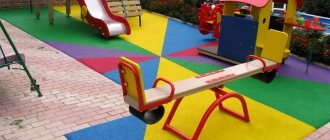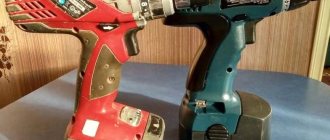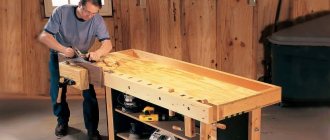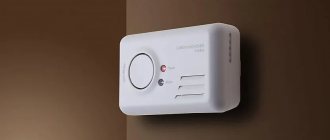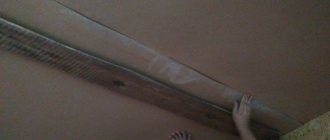When purchasing a country house or dacha, the buyer usually receives a plot covered with vegetation.
There are many devices for mowing grass, equipped with different types of motors, including electric ones.
Trimmers with this type of motor are called electric scythes, or electric trimmers.
Correct use of this garden equipment is the key to accurate grass cutting and long service life of the device.
If we mow the grass incorrectly, then there is a high probability:
- damage to the electric scythe;
- unsatisfactory mowing results;
- electric shock;
- various injuries.
How to prepare an electric trimmer?
To prepare the electric scythe for work, do the following :
- assemble a collapsible trimmer rod, which we described in detail here;
- install the appropriate cutting tool for the task (only for devices equipped with a trimmer head and a knife or disk);
- check the condition of the wire and cable;
- lay the cable to the work site.
If you have a device with a collapsible rod, then assemble it as indicated in the operating instructions. Since manufacturers of such equipment use different methods of connecting and fixing shafts, rely only on the operating instructions , do not use videos posted on the Internet and other dubious sources of information.
After all, what is suitable for one model is not always applicable to another, and trying to do it as you saw or read in a dubious source can lead to damage to the device.
If your mower comes with more than one type of cutting tool, choose the one that best suits the task at hand.
remember, that:
- the fishing line severely injures the grass, but does not damage the trees;
- a two- or three-bladed knife carefully cuts the grass, but even the shoots of bushes, and even more so thick branches, pose a threat to it;
- The saw blade is not afraid of branches, but it seriously injures the grass.
To check the wire and cable, carefully inspect them, trying to detect the slightest damage to the insulation and exposed sections of the wire. If such a defect is found, repair the wire and repair or replace the extension cord .
Also make sure that the wire plug is securely fixed in the cable so that it does not fall out of it even under strong vibration. Before laying an electrical cable, carefully consider the trajectory of your movement around the site.
the following trajectories are optimal for mowing grass with an electric trimmer :
- back and forth with a shift towards the far edge of the area on each pass;
- left-right with a forward shift on each pass.
Following these paths will allow you to keep the cable behind you at all times, which means you won't get tangled in it or cut it with the trimmer's cutting tool.
Pruning
It is convenient to trim flower beds, lawns and paths along the edges with an electric trimmer with a bottom motor, since its cutting plane can be placed vertically. For an even greater effect, it is useful to dig a groove about 4x4 cm along the cutting line. Then the line will cut the grass below ground level without touching its surface. The result is a very clean, blemish-free vertical haircut.
Preparing the area for mowing
To prepare the area for mowing, walk around the area and remove all interfering objects, that is :
- any cut or broken branches;
- boards;
- stones;
- fittings;
- wire;
- construction or household waste, including plastic and glass bottles.
Remember, any rubbish on the site can cause a breakdown or injury, because if it gets under the cutting tool, it either damages it or flies off to the side at high speed.
Pieces of brick or glass bottles can break into pieces , each of which will fly along an unpredictable trajectory, so remove all debris from the area before you start mowing.
Features of operation of different types of brush cutters
- Petrol mowers must not be refueled when the engine is hot, including simply opening the fuel tank cap.
- Cordless scythes are usually well protected from moisture, but this issue should still be approached with increased attention: make sure that water does not get into the battery socket or its contacts. This can lead to a short circuit and battery failure.
- Electric trimmers can only be used if the power cord and extension cord are completely intact. The latter, by the way, must be designed for outdoor use and have a waterproof outlet. Mowing grass damp from dew, fog or rain with an electric unit is prohibited: water can lead to a short circuit or electric shock.
Safety precautions
An electric trimmer is a potentially dangerous device, and safety regulations have been developed taking into account accidents that occur when working with such equipment.
These are the rules:
- Before starting work, be sure to check the condition of the cable connecting the outlet and the electric braid; if it has even a small defect, repair or change it.
- Before starting work, inspect the electric trimmer, check that all bolts and nuts are tightened, that there are no loose parts, and that there are no chips exposing the wires. If any of this is found, fix the defect yourself or take the device to a service center for repair.
- Wear clothes without loose elements, fasten them with all buttons or close them with a zipper.
- Use shoes with non-slip soles.
- Be sure to wear protective equipment, such as goggles or a mask.
- Do not use a trimmer that has the wrong cutting tool installed for the area.
- Do not mow the grass in a cluttered area.
- Do not start mowing if you feel unwell or are under the influence of alcohol or other substances that affect the speed of reaction and the adequacy of assessing what is happening.
- If there are people standing near the mowing site, ask them to move away so that grass or lumps of earth and small stones caught under the cutting tool do not fly off into them.
- Before mowing for the first time and at the beginning of each season, carefully read the operating instructions for your electric trimmer.
- Observe the operating mode and do not allow the device to overheat.
- Use the electric mower only for cutting grass. Remember, if you need to trim or cut down a tree, use a hedge trimmer or chainsaw, not a power trimmer.
- Do not allow children to play with this instrument.
- Do not carry the trimmer by the power cord.
- If you stop working even for a few minutes, including to clean up chopped vegetation, be sure to unplug the device.
- Watch the position of the cable so that it does not get under your feet or get caught under the cutting tool.
- Do not use the electric mower when it is raining or when the grass is covered with dew. If for some reason the device gets wet, take it to a service center to check and dry it or perform these steps yourself.
- Check the condition of the ventilation holes every 10–15 minutes and clean them if necessary.
- Do not try to mow the grass as quickly as possible, otherwise you will overload the motor and the device will break.
- If you feel that the motor or gearbox is hot, but you have not exceeded the operating time or overloaded the electric cutter, take it to a service center for inspection and repair.
- Do not fix the switch in the “on” position with tape, wire or any other method, only hold it with your fingers.
- Do not mow the grass after it has rained or until the dew on it has dried.
Working in wet weather
If you need to trim with a trimmer in any weather, it should be gasoline because it tolerates wet weather. Although, according to the instructions, some manufacturers of such gasoline equipment are also prohibited from working in the rain or on wet grass. When choosing a trimmer you should also pay attention.
The electric motor is the most vulnerable point to moisture in cordless trimmers. Accordingly, if it is located on top, it is less likely to receive moisture from the grass, but in rainy weather they may also not work.
Water typically enters extension cords from wet grass, where an electrical arc can occur that can ignite the insulating plastic or cause a short circuit. This defect can be "corrected" by purchasing a new extension cord or replacing the plug, but moisture entering the motor or control circuit will cause permanent damage to the trimmer. In addition, working with such a tool in the rain is simply dangerous, as there is a high probability of electric shock.
How to mow grass correctly?
Here is a description of how to properly mow grass with an electric trimmer:
- Walk around the area and remove all obstructive objects from it.
- If you have never mowed the area with an electric mower or will be using one for the first time, sketch out a layout of the area and determine the best path to follow that will keep the extension cord behind you at all times.
- Check the extension cord, then unwind and spread the extension cord around the area according to your travel plan.
- Wear suitable equipment and don't forget safety glasses or a mask. Make sure that no parts of the clothing are loose.
- Inspect the trimmer and install the appropriate cutting tool for the area. If everything is in order, plug in the extension cord, then connect it to the electric cutter.
- Stand at the edge of the area and make sure no one is near you.
- Turn on the electric trimmer motor.
- Tilt it so that the cutting tool rotates parallel to the ground and cuts the grass at the required height.
- Smoothly, with your whole body or just your hands, turn the trimmer left and right, using yourself as an axis. Depending on the height and density of the grass, spend 1-3 seconds on each turn.
- After each turn from the extreme left to the extreme right and vice versa, move forward 1–10 cm, the distance depends on the parameters of the grass, engine power and your skill, so take your time, develop your skill.
- Listen to the sound of the engine running; if it changes while mowing the grass, it means you have either gone too far or are turning it left and right too quickly.
- After working for the time specified in the operating instructions, release the power button of the device, then disconnect it from the extension cord. Inspect the trimmer, check the condition of the ventilation windows and the amount of grass on the inner surface of the protective screen, and also feel the housing around the motor or the motor itself. Allow for barely noticeable heating. If your hand feels hot or cannot be held on the body/motor for a long time, stop mowing and take the device to a service center to check its condition.
- If everything is fine, wait 10-15 minutes for the motor to cool down and continue mowing.
- When you're done, unplug the trimmer and clean it thoroughly, then check all mounts and vents, and measure the engine temperature by hand. If you detect overheating, make sure that you have not exceeded the permissible operating time and did not allow excessive load, then take the device to a service center for inspection and repair. If heating is caused by overload or too long work, do not allow this to happen again and carefully monitor the temperature, and at the first sign of overheating, take the electric scythe to a service center.
- When the mowing season comes to an end, clean the device from any remaining grass and place/store it in a dry, ventilated area, and take the extension cord there as well.
Instructions on how to use a gasoline trimmer, learning how to start the tool
Before using the tool, it must first be started. Let's look at how to start a lawn mower in detail. To begin with, the tool should be placed on a flat surface so that the disk attached to the shaft does not cling to anything. After this, we proceed to start the engine of the lawn mower:
- Initially, you should pump fuel into the starting system. To do this, press the primer 4-5 times (soft hemisphere on the carburetor)
- Next, turn the carburetor switch to “OFF” mode. This switch is responsible for opening and closing the air damper. Moving the switch to “OFF” mode allows you to make the fuel mixture richer during startup
- There is a switch on the handle near the accelerator. He is responsible for turning the ignition on and off. Before starting, you need to set the ignition switch to mode “1”
- Now you can launch. To do this, you need to hold the tool with one hand and sharply pull the starter handle with the other. If the scythe engine does not start the first time, then do not despair. Starting attempts must be made until the engine starts. Usually this should be done 2-3 times
- If after 5 repetitions the engine does not start, then you should repeat the fuel intake using a primer and start starting again
- As soon as the engine starts, you need to turn the choke switch to “ON” mode. This means that a mixture of fuel and air enters the cylinder
- Let the tool run for 15-30 seconds at idle until the engine warms up, after which you can start mowing the grass.
The above instructions for starting the engine of lawn mowers and trimmers are appropriate for a cold start. If there was a pause while working with the tool, there is no need to close the throttle valve when restarting the engine that has not cooled down. You simply need to turn on the ignition and pull the starter handle.
This is interesting!
If the lawn mower is new, then do not forget that it cannot be used at full capacity until it has undergone the break-in procedure. This is important to take into account, otherwise engine parts will quickly wear out and fail.
What can't you do?
Remember, an electric mower is not a lawn mower and cannot automatically maintain a constant cutting height relative to the ground, so it cannot be used to mow well-maintained lawns .
After all, any inattention will lead to a change in the mowing height, which means it will spoil the appearance of the green area.
Therefore, use an electric trimmer only where a difference in height of the cut surface is acceptable.
Due to their low power and design, electric trimmers are not suitable for cutting out dense thickets of weeds or tall wild grass. To perform this work, use gasoline trimmers or a Lithuanian scythe.
Never use an electric trimmer to cut wet grass; it is dangerous for both the grass and you. Read more about why you can’t cut wet grass with this tool here.
Types of line trimmers
There are quite a lot of them today, so everyone can make a choice based on their own needs. Cordless line trimmers are the most popular for people who want to operate independently from a power source. Examples include:
- Champion TB400 is a cordless trimmer. It has a telescopic rod, compact size and light weight, only 2.8 kilograms. A limit bracket is provided to prevent damage to useful plants;
- Gardena PowerCut Li-40/30. A professional tool that can handle even a wet lawn. Of additional note is the ability to adjust the head to work at an angle in hard-to-reach places.
Gasoline trimmers are more expensive and require regular refueling, but this pays off due to their high power and the ability to work for a long time on the site without being tied to a power source:
- Partner B305 CBS. Despite its light weight, it has impressive power. Allows you to tidy up green spaces without having a harmful effect on them by minimizing emissions. The cutting tool used is a special grass knife and a Tap&Go trimmer head operating in semi-automatic mode.
Most modern trimmers can be equipped with an additional head with a fishing line. There are four types of spin trimmer heads:
- automatic heads automatically feed filament when the throttle reaches a certain speed;
- semi-automatic heads advance the string when you press the spindle head to the ground when the throttle is applied;
- manual heads require you to turn off the trimmer before pulling or unwinding the rope to advance it;
- Fixed line heads do not provide string advancement. Instead, you use pre-trimmed replacement strings.
Storage and maintenance
Store the electric trimmer in a dry place, stacking or hanging it as specified in the instruction manual. Maintenance depends on the location of the engine; on those models where the engine is at the bottom, it is enough to check the commutator brushes, replacing them if necessary.
If the motor is installed on top, then follow these steps :
- After the end of the season, thoroughly clean the gearbox of any remaining grass.
- Disconnect the gearbox from the boom, then apply lubricant to the gearbox and boom shaft. Remember, inside the rod there are bushings that act as bearings, so they need to be well lubricated for long service. If you don’t know how to do this or what lubricant to use, then read the operating instructions or take the device to a service center.
- Disconnect the motor from the boom and add lubricant to it.
- Assemble the trimmer to prevent dust from getting inside the boom.
Points 2–4 can be performed before or after the end of the season. The main thing is that before starting work, all rubbing elements are filled with lubricant.
If you want the trimmer to work for many years, be sure to check the condition of the electric motor bearings , but this action requires skill and experience.
On devices with a lower shaft, remove the cutting tool and twist the shaft with your fingers; it should unwind almost effortlessly and rotate after unwinding for at least a second.
On top shaft trimmers, check the motor while lubricating the boom. If the motor rotates with effort or stops immediately after spinning, the bearings are dry and require lubrication or replacement. Also, do not forget to check the shaft play in all planes ; if there is any play, change the bearings.
Direction of rotation
Looking further at how to properly mow with a line trimmer, you should pay attention to specific techniques that will help you achieve an ideal result. The most common mistake people make is not paying attention to the direction of rotation. Just like a circular saw throws out sawdust, a trimmer throws away debris. If it rotates counterclockwise, it pushes waste material from the left side and cuts from the right side.
So if you're driving along a path or along a curb, stay to the right and position the tool's head so it can cut and push the grass to the left. If you go the opposite way, the debris will begin to block the trimmer's path.

